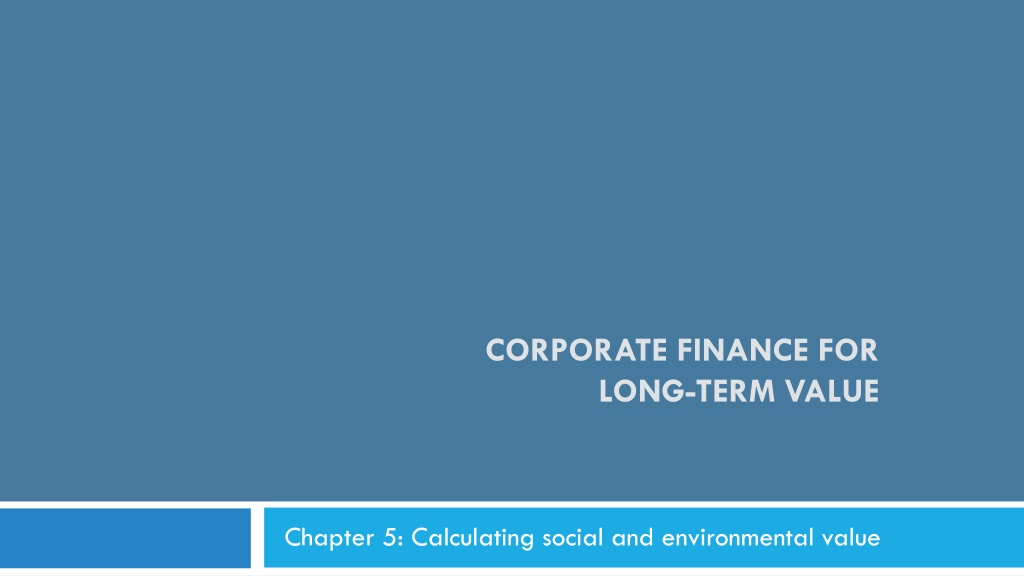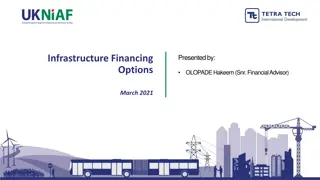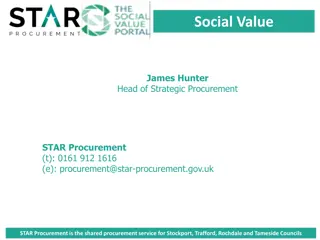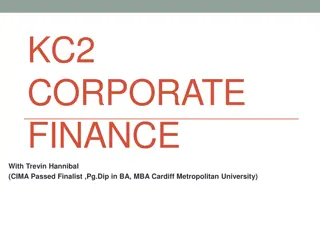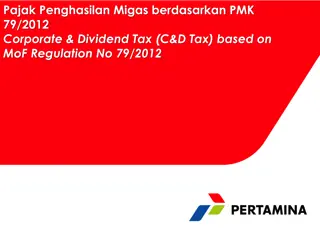Understanding Social and Environmental Value Calculation in Corporate Finance
Learn how to calculate and incorporate social and environmental values alongside financial values in corporate finance using discounted cash flow models. By selecting key factors, expressing them in relevant units, applying shadow prices, and discounting value flows, you can make social and environmental values comparable to financial values. Real-world examples illustrate the process, highlighting the importance of considering sustainability in financial decision-making.
Download Presentation

Please find below an Image/Link to download the presentation.
The content on the website is provided AS IS for your information and personal use only. It may not be sold, licensed, or shared on other websites without obtaining consent from the author. Download presentation by click this link. If you encounter any issues during the download, it is possible that the publisher has removed the file from their server.
E N D
Presentation Transcript
CORPORATE FINANCE FOR LONG-TERM VALUE Chapter 5: Calculating social and environmental value
Part 2: Discount rates and valuation methods Chapter 5: Calculating social and environmental value
The BIG Picture 3 How to make social and environmental value comparable to financial value? Solution Select material social (S) and environmental (E) factors Express them in their own units (Q) Monetise the S and E factors with shadow prices (SP) Use the standard DCF model to discount the value flows (Q * SP) The resulting SV and EV is comparable to FV
Basics of value calculation 4 The discounted cash flow (DCF) model is commonly used to calculate the value of a project or company: ? ??? 1 + ?? ? = ?=0 CF = expected cash flows r = discount rate n = number of periods This chapter shows how to calculate SV and EV using the DCF model
How to measure SV and EV 5 S and E issues can be expressed in their own units Q Then multiplied by their respective shadow price SP The calculation of the value flows is: ?? = ? ?? The social value flows SVF and environmental value flows EVF are discounted using the DCF model to obtain SV and EV: . ? ? ???? 1 + ?? ???? 1 + ?? ?? = ?? = ?=0 ?=0
Example 6 The cash flows of a steel project Year 2023 2024 2025 2026 2027 2028 -100 40 40 40 40 40 Cash flows, in $ millions 0 30 30 30 30 30 Carbon emissions, in thousands tons Use the shadow carbon price of $224 per 1 ton of CO2 to calculate EVF Year 2023 2024 2025 2026 2027 2028 -100 40 40 40 40 40 Cash flows, in $ millions 0 30 30 30 30 30 Carbon emissions, in thousands tons 224 224 224 224 224 224 Shadow carbon price, in $ 0.0 -6.7 -6.7 -6.7 -6.7 -6.7 Environmental value flows, in $ millions Total value flows, in $ millions -100.0 33.3 33.3 33.3 33.3 33.3
Example 7 Then calculate FV and EV using the financial discount rate of 6% and social discount rate of 2% respectively Year 2023 2024 2025 2026 2027 2028 -100 40 40 40 40 40 Cash flows, in $ millions 1.00 0.94 0.89 0.84 0.79 0.75 Discount factor, 6% -100.0 37.7 35.6 33.6 31.7 29.9 PV (cash flows), in $ millions Financial value, in $ millions 68.5 0.0 -6.7 -6.7 -6.7 -6.7 -6.7 Environmental value flows, in $ millions 1.00 0.98 0.96 0.94 0.92 0.91 Discount factor, 2% Conclusion: the integrated 0.0 -6.6 -6.5 -6.3 -6.2 -6.1 PV (value flows), in $ millions value is positive, so the Environmental value, in $ millions -31.7 project is worth doing! Integrated value, in $ millions 36.8
Material, social and environmental factors 8 The value calculation for SV and EV can be done in three steps: Materiality assessment - determine important SV and EV factors; 1. Quantification - express these factors in their own units Q; and 2. Monetisation - express these factors in money with shadow prices SP 3.
Materiality assessment 9 Materiality assessments aim to determine which S and E factors are important to consider Material topics are those that reflect the company s most significant impacts (positive or negative) on people and environment Materiality depends on the specific situation and can differ per industry and country A core set of factors which should always be included: Greenhouse gas emissions - including carbon emissions Labour practices - including discrimination and inclusion Business ethics - including corruption and fraud
Material social and environmental factors 10 Social factors Environmental factors Labour practices (e.g. training, Pollution (e.g. carbon emissions, discrimination) water pollution) Combatting poverty (e.g. Use of scarce resources (e.g. underpayment in value chain) scarce materials, land, water) Interaction with communities (e.g. Restoration of air, land or water regional economic activity, health & (e.g. land restoration, water safety, business ethics) purification)
Quantifying social and environmental impact 11 Expressing E issues in own units: GHG emissions: expressed in tonnes of CO2 Some issues are easily quantifiable (carbon, nitrogen or freshwater use) whereas others are more difficult to express in a single metric (biodiversity) Year 2022 2023 2024 2025 2026 2027 2028 2029 2030 30 31 22 25 31 30 29 25 20 CO2-eq. million tons Expressing S issues in own units: For example, quality of life years added by a medical company Year 2022 2023 2024 2025 2026 2027 2028 2029 2030 62 64 67 70 73 75 78 82 99 Quality life years added, x 1,000
Attribution of impact 12 A challenge is attributing (i.e. distributing) shares of the impact to each of the stakeholders For example, carbon emissions from the usage of combustion engine vehicles can be attributed to: The car manufacturer The oil company selling petrol The user of the vehicle For greenhouse gas (GHG) emissions, Scope 1, 2 and 3 emissions attribute by distinguishing: All direct GHG emissions of an organisation Scope 1 100% attribution for Scope 1 + 2 Indirect GHG emissions from consumption of purchased energy Scope 2 Other indirect GHG emissions both upstream and downstream of the value chain Scope 3 50% attribution to primary company for Scope 3 New item (not yet in GHG Protocol) saved emissions Scope 4
Monetising social and environmental impact 13 The monetary value is calculated by multiplying the quantified issues with the shadow price, which is the price to restore the original situation Monetising E issues: Year 2022 2023 2024 2025 2026 2027 2028 2029 2030 30 31 22 25 31 30 29 25 20 CO2-eq. million tons The shadow carbon price will 224 232 240 248 257 266 275 285 295 Shadow carbon price, $ Environmental value flow, $ billions increase in the future -6.7 -7.2 -5.3 -6.2 -8.0 -8.0 -8.0 -7.1 -5.9 a Monetising S issues Year 2022 2023 2024 2025 2026 2027 2028 2029 2030 62 64 67 70 73 75 78 82 99 Quality life years, x 1,000 The shadow price per quality of life 119 119 119 119 119 119 119 119 119 Shadow price, x $1,000 Social value flow, $ billions year is expected to stay constant 7.4 7.6 8.0 8.3 8.7 8.9 9.3 9.8 11.8
Welfare-based shadow prices 14 The shadow prices should reflect the true scarcity of resources to stay within planetary boundaries Organisations such as the Impact Economy Foundation and True Price provide regularly updated lists of impact and shadow prices (see Appendix of Chapter 5) True prices are based on two welfare categories: Rights (human, labour and environmental rights) Well-being
Well-being 15 Well-being, also known as quality of life, refers to what is intrinsically valuable for someone Includes: Well-being of employees additional to the salary received, measured by life satisfaction points (on a scale of 0 to 100) Well-being of customers calculated as consumer surplus, which is the difference between the price of a product and what consumers want to pay Well-being of communities
Consumer surplus 16 consumer surplus = ? ? 1 2 ? = maximum price Pmaxminus price paid P ? = number of goods sold price elasticity = ?/? ?/? which leads to: ????? ?????????? 1 ? ? ????? ?????????? 1 ????? consumer surplus = 2= 2
Calculating social and environmental value 17 Using the social (SVF) and environmental (EVF) value flows, you can determine social (SV) and environmental (EV) value: ? ? ???? 1 + ?? ???? 1 + ?? ?? = ?? = ?=0 ?=0 Year Social value flows (SVF), $ billions Discount factor, 2% 2022 2023 2024 Year Environmental value flows (EVF), $ billions Discount factor, 2% 2022 2023 2024 7.4 7.6 8.0 -6.7 -7.2 -5.3 1 0.98 0.96 1 0.98 0.96 -6.7 -7.0 -5.1 PV (EVF) 7.4 7.5 7.7 PV (SVF) Environmental value (EV) -57.6 Social value (SV) 73.3
Examples 18 This chapter shows that SV and EV can be measured and valued We can now calculate IV = FV + SV + EV Ch 6 and 7 provide examples for projects - from Net Present Value (NPV) of FV to Integrated Present Value (IPV) Ch 7 provides case study for integrated value of Inditex
Conclusions 19 Recent advances in impact measurement enable companies to measure social and environmental quantities and to multiply them by their respective shadow price The challenge for calculating social value (SV) and environmental value (EV) is the availability of company information on S and E issues It is important to keep the big picture by focusing on material S and E issues, and not to get lost in unnecessary detail Remember: better to be approximately right than exactly wrong
